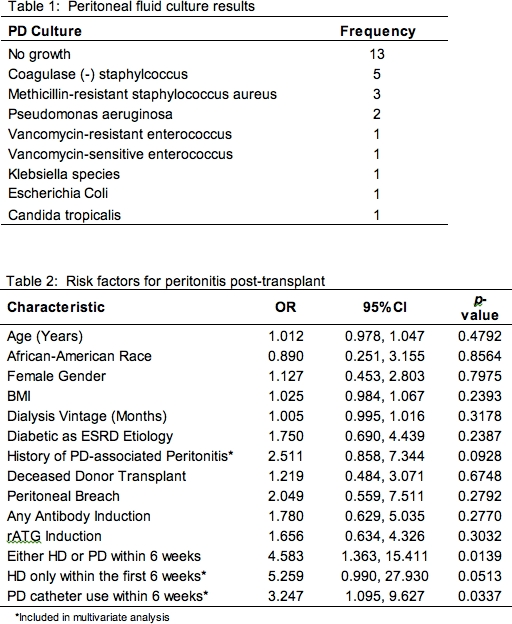Risk of Peritoneal Dialysis Catheter-Associated Peritonitis Following Kidney Transplant.
1Department of Surgery, University of Michigan, Ann Arbor, MI
2Department of Internal Medicine, University of Michigan, Ann Arbor, MI.
Meeting: 2016 American Transplant Congress
Abstract number: D252
Keywords: Infection, Kidney transplantation, Morbidity, Post-operative complications
Session Information
Session Name: Poster Session D: Poster Session II: Kidney Complications-Other
Session Type: Poster Session
Date: Tuesday, June 14, 2016
Session Time: 6:00pm-7:00pm
 Presentation Time: 6:00pm-7:00pm
Presentation Time: 6:00pm-7:00pm
Location: Halls C&D
While peritoneal dialysis (PD) has become more common, PD catheter management at the time of kidney transplant varies widely by transplant center. We sought to determine the risk of PD catheter-associated peritonitis following transplant.
Methods: Demographic and outcomes data were collected from 313 sequential PD patients who underwent kidney transplant from 2000-2015. Risk factors for postoperative peritonitis were analyzed by logistical regression.
Results: Of 329 patients with PD catheters at transplant, 16 PD catheters were removed at engraftment. For those with planned delayed removal, median age was 48 years (range 18-75 years), with 242 Caucasian patients, 51 African-American patients, and 20 patients of other ethnicities. Of these patients, 49 (15.7%) required hemodialysis (HD) or PD within 6 weeks of transplant and 20 (6.4%) had at least one episode of postoperative peritonitis. Most frequently, peritonitis was diagnosed by cell count, with Staphylococcal species the most common cultured source of peritonitis (Table 1). On univariate analysis, patients who suffered peritonitis were significantly more likely to have used the PD catheter or required either modality of dialysis (Table 2), with a trend seen for those with a history of pre-transplant peritonitis. Multivariate analysis, including risk factors with p<0.20, had similar findings, with increased risk for those using the PD catheter (OR 3.680; 95%CI 1.211, 11.185; p=0.0216), with a near significant trend for those who had HD only within 6 weeks of transplant (OR 5.351; 95%CI 0.938, 30.535; p=0.0591), while peritonitis history was not significant (HR 2.237; 95%CI 0.730, 6.852; p=0.1586).

Conclusion: Although the frequency of post-transplant peritonitis was small, PD catheter use after transplant was relatively uncommon. PD catheter use was associated with peritonitis after transplant. However, a similar trend in postoperative peritonitis was seen in patients only utilizing HD, suggesting that any delayed graft function may increase peritonitis risk.
CITATION INFORMATION: Rizzi A, Ruitta S, Peterson J, Gagin G, Fritze D, Sung R, Lu Y, Woodside K. Risk of Peritoneal Dialysis Catheter-Associated Peritonitis Following Kidney Transplant. Am J Transplant. 2016;16 (suppl 3).
To cite this abstract in AMA style:
Rizzi A, Ruitta S, Peterson J, Gagin G, Fritze D, Sung R, Lu Y, Woodside K. Risk of Peritoneal Dialysis Catheter-Associated Peritonitis Following Kidney Transplant. [abstract]. Am J Transplant. 2016; 16 (suppl 3). https://atcmeetingabstracts.com/abstract/risk-of-peritoneal-dialysis-catheter-associated-peritonitis-following-kidney-transplant/. Accessed January 7, 2026.« Back to 2016 American Transplant Congress
